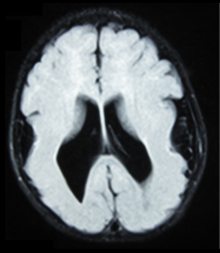
This term refers to a heterogenous group of disorders that, it is supposed, share the same etiopathological mechanism: a variable degree of disruption in the migration of neurons during neurogenesis[1]. The neuronal migration disorders are cerebral dysgenesis, brain malformations caused by primary alterations during neurogenesis; on the other hand, brain malformations are highly diverse and refer to any insult to the brain during its formation and maturation due to intrinsic or extrinsic causes that ultimately will alter the normal brain anatomy. However, there is some controversy in the terminology because virtually any malformation will involve neuroblast migration, either primarily or secondarily.
Some specific disorders considered as alterations in neuronal migration are lissencephaly, pachygyria, polymicrogyria and focal cortical dysplasia, while the Miller Diecker syndrome, muscle-brain-eye syndrome, Fukuyama's muscular dystrophy and Walker Warburg syndrome are genetic disorders associated with this malformations.
==References==
- ^ Sarnat, Harvey (1992). Cerebral dysgenesis, embryology and clinical expression. New York, US: Oxford University Press. ISBN 0-19-506442-9.